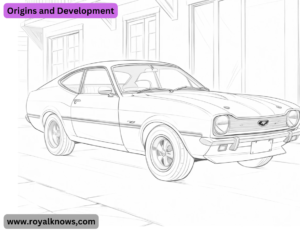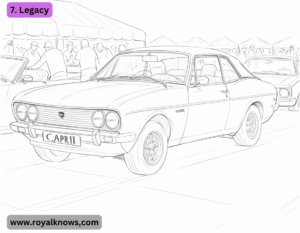Ford Capri The Ford Capri is a classic car that was produced by Ford of Europe from 1968 to 1986. It was designed as a European equivalent to the Ford Mustang, offering a sporty coupe with a range of engine options. Here are some key points about the Ford Capri:
Generations:
- First Generation (1968-1974): Known as the “Capri Mk I,” it was available with a variety of engines, from 1.3L to 3.0L V6.
- Second Generation (1974-1978): The “Capri Mk II” featured a more modern design and improved aerodynamics. It continued to offer a range of engines, including the popular 3.0L V6.
- Third Generation (1978-1986): The “Capri Mk III” had a more angular design and was the last generation of the Capri. It included high-performance models like the Capri 2.8 Injection and the Capri 280 (Brook lands).
Performance Models:
- Capri RS2600: A high-performance version of the Mk I, featuring a 2.6L V6 engine and used in touring car racing.
- Capri 2.8 Injection: Introduced in the Mk III, it featured fuel injection and improved performance.
- Capri 280 (Brook lands): A limited-edition model produced at the end of the Capri’s production run, featuring a 2.8L V6 engine and special Brook lands Green paint.
Popularity:
- The Capri was immensely popular in Europe, especially in the UK, where it became a cultural icon. It was known for its affordability, sporty design, and versatility.
- It was also successful in motorsport, particularly in touring car racing.
Legacy:
- The Ford Capri has a strong following among classic car enthusiasts
- and is often seen at car shows and events.
- Its design and performance have made it a memorable model in Ford’s history.
Origins and Development
- The Ford Capri was conceived as a European
- counterpart to the Ford Mustang, which was a huge success in the U.S.
- Ford wanted to replicate the Mustang’s formula: a stylish, affordable, and sporty coupe with a range of engine options to appeal to a broad audience.
- The project was led by Philip T. Clark, who had also worked on the Mustang.
- The Capri was designed to be a “European Mustang”
- but tailored to European tastes and road conditions.
- It was built on the same platform as the Ford Cortina,
- which helped keep costs down and
- allowed for shared components.
2. Design and Features
- Styling: The Capri featured a long hood, short rear deck, and a fastback roofline, giving it a sporty and muscular appearance. The design was simple yet elegant, with a focus on aerodynamics in later generations.
- Interior: The interior was practical and driver-focused, with bucket seats and a sporty dashboard. Later models featured more luxurious touches, such as plush upholstery and improved ergonomics.
- Engines: The Capri was offered with a wide range of engines,
- from small 1.3L and 1.6L inline-4 engines to larger 2.0L,
- 2.6L, and 3.0L V6 engines.
- This allowed buyers to choose a model that suited their budget and performance needs.
- Performance: The top-tier models,
- like the Capri RS2600 and Capri 3.0S,
- were known for their impressive performance,
- with the 3.0L V6 producing around 138-150 horsepower.
3. Motorsport Success
- The Ford Capri was a dominant force in touring car racing during the 1970s. It competed in series like the European Touring Car Championship and the British Touring Car Championship.
- The Capri RS2600 was particularly successful, winning the European Touring Car Championship in 1971 and 1972.
- In rallying, the Capri also made a name for itself, with modified versions competing in events like the RAC Rally.
4. Cultural Impact
- The Capri became a cultural icon, especially in the UK
- , where it was associated with the “working-class hero” image.
- It was affordable enough for young buyers but still had a sporty, aspirational appeal.
- It appeared in numerous TV shows and movies, including “The Professionals” and “Minder,” further cementing its place in popular culture.
- The Capri was also a favorite among car enthusiasts who modified it for better performance or custom styling, making it a staple of the modified car scene in the 1970s and 1980s.
5. Special Editions and Models
- Capri RS2600: A homologation special for racing, featuring a 2.6L V6 engine with fuel injection and distinctive styling.
- Capri 3.0S: A high-performance model with a 3.0L V6 engine, sporty trim, and improved handling.
- Capri 2.8 Injection: Introduced in 1981, this model featured fuel injection, improving performance and fuel efficiency.
- Capri 280 (Brook lands): The final edition of the Capri, limited to 1,038 units. It featured a 2.8L V6 engine, special Brook lands Green paint, and luxurious interior trim.
6. End of Production
- Production of the Ford Capri ended in 1986 after nearly two decades. By then, the market had shifted towards front-wheel-drive hot hatches like the Ford Escort XR3i and Volkswagen Golf GTI.
- Over 1.9 million units were sold during its production run,
- making it one of Ford’s most successful models in Europe.
7. Legacy
- The Capri remains a beloved classic car, with a strong enthusiast community.
- It is often celebrated at car shows and events, particularly in the UK.
- Its influence can be seen in later Ford models,
- such as the Ford Probe and Ford Cougar,
- which attempted to capture the spirit of the Capri.
- In 2018, Ford teased a modern interpretation of the Capri with the Ford Capri Concept, sparking rumors of a revival, though nothing has materialized as of 2023.
8. Fun Facts
- The name “Capri” was chosen to evoke a sense of style
- and sophistication, inspired by the Italian island of Capri.
- In Germany, the Capri was sold under
- the Mercury brand as the Mercury Capri.
- The Capri was also assembled in Australia
- and South Africa, where it gained a loyal following.
9. Why the Capri Matters
- The Ford Capri was more than just a car; it was a symbol of freedom, style, and performance for a generation. Its affordability and versatility made it accessible to a wide audience, while its sporty design and performance capabilities made it a true driver’s car.
- Today, the Capri is remembered as one of Ford’s most iconic models,
- a testament to the golden era of affordable sports coupes.
Technical Specifications
The Ford Capri was known for its versatility, offering a wide range of engines and configurations.
Engines
- Inline-4 Engines:
- 1.3L (1298 cc) – 53-60 HP
- 1.6L (1598 cc) – 72-88 HP
- 2.0L (1993 cc) – 98-110 HP
V6 Engines:
- 2.6L (2637 cc) – 125-150HP (used in the RS2600)
- 3.0L (2994 cc) – 138-150 HP
Fuel Injection:
- The Capri 2.8 Injection (1981-1986) featured a 2.8L V6 with Bosch K-Jetronic fuel injection, producing 160HP and improving both performance and fuel efficiency.
Get article on pdf file…Click now
…….Ford Capri…….



